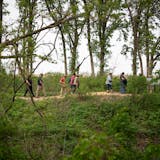MINNEAPOLIS
Hennepin Healthcare Clinic and Specialty Center
This consolidation effort places more than two dozen far-flung clinics and practices under a single, convenient roof. From the street, the colorful and welcoming six-story structure is the exact opposite of its neighbor, the colossally grim Hennepin County Medical Center, a 1975 concrete fortress that turns its back on the street with such force that, if it were a person, it would require the services of a chiropractor. This $225 million newcomer deftly connects to the city with an undulating glass facade that vividly demonstrates its purpose in a single glance. Opening March 26.
Architects: BWBR, St. Paul
The Dayton's Project
A private investment of nearly $200 million will restore this historic megastructure (portions of which date to 1902) to its rightful place as a downtown crossroads. Most of the former department store's 12 aboveground floors will be converted to office space, but the public will find plenty of reasons to visit, with three levels (basement, street and skyway) devoted to retail and a massive food hall. One of the project's most appealing features — and there are many — is the way it will make the building's key relationship to Nicollet Mall more porous and inviting. Opening in 2019.
Architects: Gensler & Associates, Mpls.
Hub Minneapolis
If nothing else, its 284-foot height is working wonders to reduce the menacing presence of its hulking, Brutalist neighbors on the University of Minnesota's main campus, the Malcolm Moos Health Sciences Tower (295 feet) and Phillips-Wangensteen Building (210 feet), arguably the state's ugliest high-rises. But this 26-story apartment tower is more than a skyline tranquilizer. It's a glass-sheathed, $100 million investment in urban density (when it opens this summer, its 430 units will house nearly 700 students), and its contemporary design is a welcome departure from the interchangeable low-rise apartments that have sprung up near the U. Here's hoping that some of the dining institutions that it replaced (the Village Wok, the Big 10) will return to the building's first floor.
![Three weeks ago, Octavio Rodriguez switched from making transmission parts to casting parts for hospital bed brake assemblies at Twin City Die Castings. ] GLEN STUBBE • glen.stubbe@startribune.com Thursday, April 9, 2020 How employee-owned Twin City Die Casting, which just laid off 40 production workers of its 250 employees in what was supposed to be a good year, is trying to accelerate its pivot to growing medical parts business for ventilators, hospital beds, etc as it copes with instan](https://arc.stimg.co/startribunemedia/WNZYKGTZ5IYMUCO3KI5TR3N7WI.jpg?&w=80&ar=1:1&fit=crop)
djoles@startribune.com As boaters flock to Minnesota lakes and rivers this holiday weekend for the unofficial kick-off to the boating season, they'll face more inspections in and out of the water as local cities and counties ramp up their work to stop the spread of invasive species. Across the metro, more boat accesses will be staffed by watercraft inspectors thanks to $10 million funneled to county government programs this year, up from $4.5 million the state allocated last year. ORG XMIT: MIN1505222156290209 ORG XMIT: MIN1506021218440580](https://arc.stimg.co/startribunemedia/34QSKO44B2XKVNUZCO5SLJQSLY.jpg?&w=80&ar=1:1&fit=crop)

